
1920s
BURLINGTON LANDMARKS
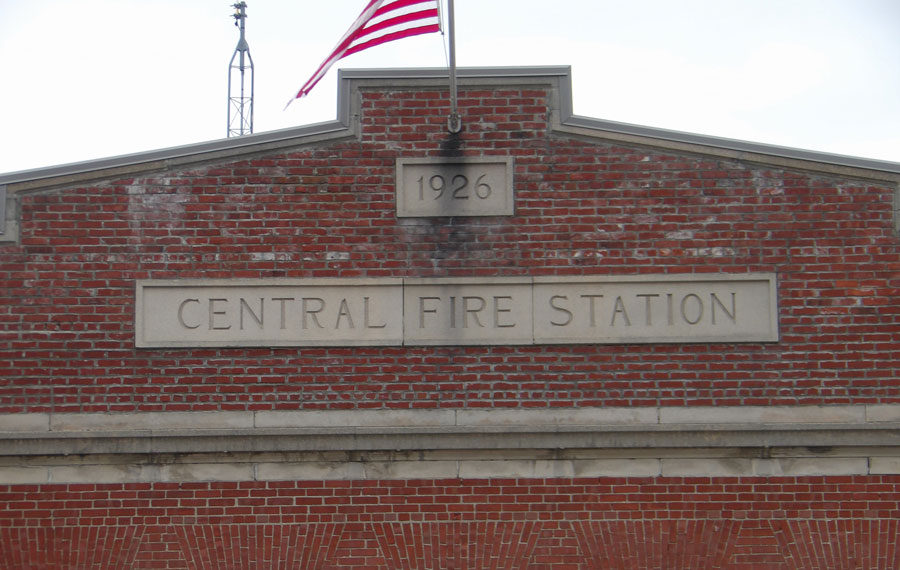
A Model Fire Station: Progressive Change in Burlington, Vermont
By Gabrielle Fernandez
Burlington, like many cities both big and small, was expanding during the 1920s. Its fire and public safety personnel were growing, just as those they were sworn to protect were flocking to the bustling commercial city. For these public servants, they were witnessing a change in an era. Within the past two decades technological advances in the firefighting field had transformed the profession. In a mere generation, hose drying technology had improved, infrastructure had been developed, water pressure intensified, and the most important factor of all, the automobile replaced the horse-drawn engine. All of these factors and more would influence the City of Burlington when they decided to construct their new fire station, Central Fire. Central Fire Station is located at 136 South Winooski Avenue, in Burlington, Vermont. This massive masonry structure, built between 1926 and 1927, was the first of three great public works projects during the latter half of the 1920s for the City of Burlington. For a project of this scale and importance, meant to usher Burlington into a new phase of existence, the City turned to architect Frank L. Austin, who, having worked in several regions of Vermont within the past decade, had the knowledge and expertise to build the new station.1
The City of Burlington was in desperate need of a new fire station. In the years prior to its creation, the Burlington Fire Department faced considerable stress in dealing with fire-related incidents. Nothing illustrates this trend better than the yearly Report of the Insurance Commissioners of the State of Vermont. Critically looking at this data, beginning roughly in 1908 and up to 1925, we can see that although Burlington is but one of 16 towns and cities in Chittenden County, it consistently accounted for one third to one half (and sometimes slightly more) of all fire related calls in the entire county.2 While Burlington constantly made up a majority of the incidents during this period, the cost associated with doing so varied considerably: while in one year it may be less than a tenth of overall fire-related damages, other year (such as 1918) Burlington fire costs represent 93 percent of the overall county related costs.3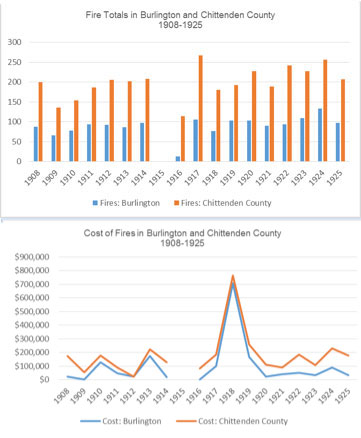
Despite this yearly increase in costs associated with fires, the fire insurance business in Burlington steadily stayed afloat. Incorporated in 1906, the Burlington Mutual Fire Insurance Company, a division of Vermont Mutual Fire Insurance Co., set up shop in Burlington during this period to serve the rapidly increasing number of customers affected by the high number offices in Burlington. When they began business on June 1, 1907, they set up shop with a cash balance of $12,000, in addition to funds directly tied into stocks. By 1925, the cash balance of this company was now $92,000, with its stock funds multiplying considerably.4
Though the insurance companies benefited, the people of Burlington needed a safer, more fire efficient department to serve their ever increasing demands. To satisfy this need, along with the need for a new city hall and auditorium the people of Burlington voted to pass a $750,000 bond for the new construction projects, and, while the projects went over budget by $100,000, all projects were completed, despite the financial meltdown that was the Great Depression. The Central Fire Station was relatively inexpensive in comparison to the other projects: a mere $100,000 of taxpayer money.5 A Burlington Free Press Article from October 16, 1925 emphasizes the significance of these projects: “The people of this city should hereafter celebrate October 14 as Greater Burlington Day… as the date when our taxpayers voted… to put Burlington in the very vanguard of progressive cities.”6
The creation of the new fire station was part of a larger trend of fire related improvements that the city made during the 1920s. The Burlington City Reports detail that the fire-related budgets for the 1920s was steadily increasing, paying for technological improvements, salary increases, and the replacement and repair of hydrants and alarm boxes. During this period, the cost of departmental operations steadily increased each year, from $48,228.50 in 1920 to $67,310.43 in 1927, an increase of 40 percent. As associated costs rose, budgeting in general increased in kind, keeping overdrafts minimal by slowly selling off outdated department equipment, such as the four horses that were considered too old for service as per veterinary assessment.7
Much of this change in cost correlates directly to improvements in fire apparatus and the hire of new men to meet increasing demand. Nearly every year, the department would purchase items of varying cost to improve efficiency, although Chief Carl D. Stockwell would continually ask for a higher appropriation from the city government each year to account for all the improvements that needed to be made, mainly regarding the conditions of much of the hose. Between 1923 and 1927 alone, nearly 20 new men were hired to meet this increasing demand. This meant a regular pay salary rise of $41,841.15 to $57,052.59, a jump of 36 percent.8
Between 1920 and the unveiling of the new fire station in 1927, not only was the Burlington Fire Department going through a massive period of change within the department itself, but also how the department worked with other related departments within the city. In the short period of just seven years, the Fire Department partnered with the Water Department to replace, move, or repair 155 fire hydrants during this period. Additionally, the amount of fire hydrants went from 272 (224 public and 48 private) to 292 during this period, a seven percent increase in as many years. And as new fire services were added to the existing system, the Water Department followed Chief’s suggestion, using six inch or more in diameter pipes to better assure quality water pressure. In the surge to improve the Fire Department, the help from the Water Department cannot be ignored.9
In the years leading up to the project, it is evident that the Water Department worked closely with the Fire Department, however it was the Street Department that contributed the most to the project itself. The preparation and multi-department partnership to break the ground for this building evidently reflects the massive taxpayer sacrifice for the purchase of the new station. Outside of the necessary help by the Fire Department, the Street Department did a remarkable job for getting the site ready for construction. They were involved in several different stages of the construction, working alongside the many different contractors who had won bids to work on various parts of the building, depending on their specialty.10
Street Department contributions at the site for the year 1926 were completed during the colder early months of the year, for they had to wait for the demolition and removal of the Old City Market that was the site’s previous inhabitant. During these few months, the department worked furiously to widen the road, removing old stone curbs and replacing them with concrete curbs, pavement, and sidewalks. These contributions alone amounted to $2100, part of a special city appropriation for assistance with the project. The department then excavated the site to ready it for construction, but only after soil tests were completed to ensure proper load bearing strength, information given to the architect Frank L. Austin and the City Engineer, who was active during all steps of the approval process. Once this step was completed, the department constructed the entire sub-foundation, and then in late spring when additional municipal labor was needed, they assisted with additional excavation, this time for a rear entrance, the construction of a manhole and sewer in the rear, and extensive grating.11
In the following year, the Street Department contributions amounted to finishing touches to help finish the project. Once the retaining walls had been completed, they did all the backfilling and poured an asphalt joint filler. Additionally, they paved the rear entrance on Main Street to allow fire equipment entrance to the basement level for necessary maintenance. All of this work was just in time for the grand public unveiling.12
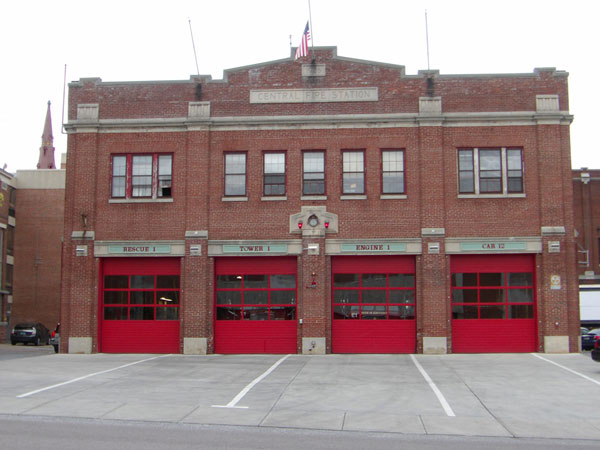
When the work was completed and ready for operation, the public response was a grand affair. Hundreds of Burlingtonians visited the newly erected structure on February 26th and 27th, enjoying the privileged experience of looking behind the scenes before the firemen would move into their new home. For the new building, two engines and the chief’s car were transferred to Central Fire from Station One, while an aerial truck was transferred from Station Three. A Burlington Free Press writer details the opening: “All in all, comments made by visitors to the firemen over the weekend were to the effect that Burlington has a fire station and a fire department which it well has the right to point out with pride to tourists and other vacationists this summer.”13
Burlington residents indeed had a reason to be proud: this building was, for its time, state of the art. A new Gamewell fire alarm system was installed in the building just after its creation, allowing for a better relay and better fire response times.14 These new Gamewell alarms increased the speeds at which calls were sent in and the speed in which it was able to record the calls, automatically stamping the box number, location, and time, with one clerk assigned to monitor the alarms. Simultaneously, another piece off apparatus would record the hour, day, month, year and time when the fire is rung out, to be filed and saved by the department. By installing this new system, the trucks were assured to take the shortest response route after receiving a call. Additionally, when an alarm came in to the station, the lights immediately were turned on in fireman-occupied rooms to ensure response in the most minimal of times.15
Other alarm innovations arose with this new “model” fire station. Though alarms were not attached to engines during this period, the Burlington Fire Department still found a way to ensure optimum safety: two large fire alarms were erected near by the Central Fire Station that automatically went off when a call came into the station. These served as warning signals to traffic that the fire apparatus would soon be passing through, adding to the safety of those traveling and the firemen. Furthermore, these sirens would operate on curfew, and toll a test alarm daily at 8:50 AM.16
In addition to the new and improved alarms, the Fire Department had to remedy other safety concerns when choosing the location of 136 South Winooski Avenue. In previous years, the department had to maneuver through the constantly congested Church Street to reach its destinations, the possibility arising for pedestrian harm especially during the warm summer season. To remedy this issue, the Street Department widened South Winooski Avenue between College and Main, decreasing the liability for injury and accounting for the increasing size of these fire-fighting apparatus.17 By widening the street to 40 feet between curbs, the Street Department ensured maximum public safety.18
For Burlington residents, this fire station did not just represent an insurance for their increased safety, but that of the firemen as well. Their new home, while not extravagant, had a kitchen, hot and cold water, and bathroom facilities, something that not everyone had in their own homes. To them, this was practical, an attempt to hearten the men to rush into the bitter cold and deal with exposure, knowing that a warm, rejuvenating shower awaited them at the station. A reporter writes with endearment on the topic:
“Many of the people of Burlington know from personal inspection that our city has one of the finest and most up-to-date fire stations to be found anywhere. In location, architecture, design, material, arrangement and equipment it seems absolutely to leave nothing to be desired.” “Our ‘fire laddies’ are very manifestly tremendously proud of their new home and headquarters and have every right to take pride in the new structure. It will help them to make their work of protecting our city from the fire fiend to a veritable ‘labor of love.’”19
The changing times were clearly represented in the design of Central Fire Station, part of why citizens felt truly proud of their new structure. This fire station was the first of Burlington’s stations to feature an all automotive fleet, ready to go at a moments notice.20 Due to hose drying technological improvements, the need for a tower to dry the hoses was no longer necessary, the form of the building itself clearly displaying this fact: it was the first fire-fighting structure in Burlington in which one finds this factor absent. With electrical achievements also came the fact that Central Fire was entirely modernized: its interior features acknowledged the presence of its state of the art Gamewell alarm system and operating space for its clerk. For Burlington residents, this station represented the rapidly improving status of the 20th century fire-fighting field, ready to protect them right in their own back yard.
What did this innovation mean for the other Burlington fire stations? Central Fire Station replaced the old Ethan Allen Club Station Number One, which would later be altered and upgraded for use by the Burlington Police Department, only narrowly avoiding demolition with the creation of a New City Hall. The other stations, Station One on North Champlain Street and Station Three on Mansfield Avenue were to be maintained so that no lapse would occur when responding to calls. To staff the new station, firemen from Stations One and Three were transferred from the older stations for maximum operating efficiency.21 An intermittent fifth station fluctuated in use by the department during this period, but much of the focus was on the new Cadillac of fire stations, Central Fire.22
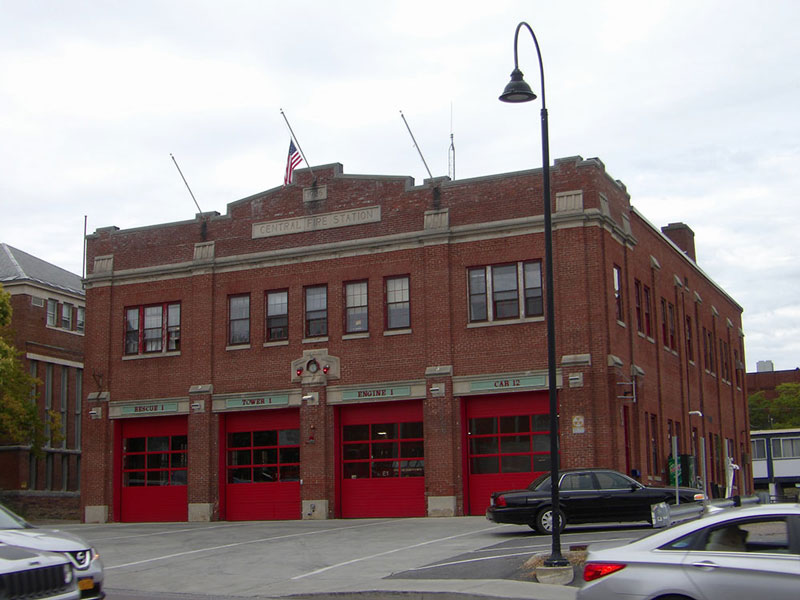
Though other stations were still in use, for residents of Burlington, this new structure held all the charm. When they first visited the station, residents of Burlington were awed. At 65 feet 6 inches wide and 88 feet 7 inches deep, the building was quite grand for the small city. Its large four bays on the first floor held two Seagrave 750 gallon pumpers, churning out 130 horse power, both equipped with the highest regulation hose, in addition to one Seagrave ladder truck that could also function as a water tower, one Ford one-ton truck, and the chief’s car. What's more, this floor also housed 360 feet of ladders and the prized Gamewell system, its associated circuit boards, batteries, recording sets, punching registers, transmitters, wheels, transformers, repeaters, and generators all carefully mounted, ready for use in two separate fireproof rooms.23
The second floor was equally awe-inspiring. On this floor there was a recreation room, a bathroom, a clean-up room, a kitchen with a pantry, the chief’s office, the assistance chief and captain’s office, and 14 rooms that slept two men per room for their lengthy shifts. The basement, though hidden from the public eye, was expansive, with room enough for a coal room, a boiler room, and storage space, as well as housing space for maintenance. Despite all the equipment, there was still capacity on this level to house a 60 foot long and 10 feet wide hose drying rack, a symbol of past firefighting days that were slowly changing.24
Though many aspects have been updated over the buildings 90 years in existence, its original form remains roughly the same.25 The most notable characteristic of the building itself, its memorable bracketed crest, still remains on the front of the building. Employees still have bedrooms for personal items and sleeping during their 24 hour shifts, each with its own large door and surrounded by frosted glass with the department insignia overhead. All of the bedrooms contains a bed, desk, and closet for personal items. Similar to the first bylaws of Burlington firefighters written in 1861 by the Ethan Allen Engine Company, there are still guidelines on decorum, uniform, and house rules.26 Three of the four fire poles remain; one was removed to allow for the creation of a weight room, its prior presence noted when one cranes their neck up to look at the second floor, noticeably boarded over yet hidden from the weight room itself. Additionally, original windows and a large bay door remains on the basement level, however the bay door is no longer able to open.27
Several aspects of this building have been altered and modified over the years. On the first floor an administrative office acts as representative for the fire department, located where the old alarms used to be housed. The second floor bathrooms have been updated, and two of the rooms on this floor have been converted to storage and utility space. The rooms along the front façade now serve as a conference room and office space for the chief. The kitchen was redone in 2001, situated next to the den with large armchairs where the men can relax and observe on the walls all the department history.28
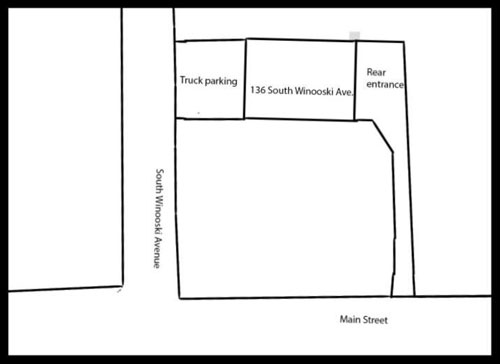
Much of the basement and the surrounding lot has also been changed. The “river,” a nickname for the sewage line that used to flow behind the building uncovered and open to the air has long since been covered with pavement. This paved area connected to a small driveway coming from Main Street that used to allow the fire-fighters to drive the engines down to the service level, but the increasing size of engines has since made this impossible. A large mechanical door still remains, allowing the employees and department to continue to use the space for work. On this level, they recently renovated what was a coal and water room, upgrading to renewable sources, raising the floor of one of the two small rooms by 14 inches, keenly noticeable when stepping through the now very small doorway. The other of the two rooms originally serving this purpose now is used for life-saving training, in addition to storage space. Additionally, a master electrician came to the building and upgraded all wiring, installing a central air and cooling system, a lengthly process lasting nearly two years. To ensure maximum efficiency the basement grated windows on the southern façade were covered on the inside. Within the past decade a sprinkler system was also installed to the building, owing to a grant awarded to the company for its first system. Though much has been changed on this level, a telltale sign of its history remains: a circa 1890s hand pulled fire apparatus, a symbol of the department’s long standing commitment to the community.29
When chronicling the history of a building, one often wonders, “Would the original inhabitants or visitors recognize this place as it stands today?” Often when looking at a building with a long history, its current state is marred by bad additions or deteriorating conditions. In this case, Central Fire Station represents an abnormality, its grounding character remains starkly similar as what it was when construction began 90 years prior. The men that call her walls their home are proud of what they do, and they know that residents still appreciate their hard work and dedication. Though we no longer refer to our fire-fighter heroes as our “fire laddies,” the respect and admiration for Central Fire Station and her workers remains with the same force as it did when the first glimpses were caught, February 26th, 1927.
Notes
1. Vermont Public Documents, Being Reports of State Officers, Departments and Institutions for the Two Years Ending June 30, 1922 (Rutland, VT: Marble City Press, the Tuttle Company, 1922), pp. 27-29.
2. Data for 1915 not available, and excluding the year 1916 where data is a severe abnormality to other yearly trends.
3. See Graphs I and II. Report of the Insurance Commissioners of the State of Vermont, 1908, (Bellows Falls, VT: P.H. Gobie Press, 1909); ibid., 1910; Report of the Insurance Commissioners of the State of Vermont, 1910, (Concord, NH: The Rumford Press, 1911); ibid., 1912; Report of the Insurance Commissioners of the State of Vermont, 1912, (Bellows Falls, VT: P.H. Gobie Press, 1913); ibid., 1914; ibid., 1915; ibid., 1916; ibid., 1917; ibid., 1918; ibid., 1919; ibid., 1920; ibid., 1921; ibid., 1922; ibid., 1923; ibid., 1924; ibid., 1925.
4. Report of the Insurance Commissioners of the State of Vermont, 1909; ibid., 1910; ibid., 1912; ibid., 1913; ibid., 1914; ibid., 1915; ibid., 1916; ibid., 1917; ibid., 1918; ibid., 1919; ibid., 1920; ibid., 1921; ibid., 1922; ibid., 1923; ibid., 1924; ibid., 1925.
5. “New City Hall - Park Frontage,” Burlington Free Press (Burlington, VT), May 12, 1928, accessed October 10, 2016, http://burlingtonfreepress.newspapers.com/image/197116410.
6. John Southwick, “The New City Hall and a Greater Burlington,” Burlington Free Press (Burlington, VT), Oct. 16, 1925, accessed October 10, 2016, http://burlingtonfreepress.newspapers.com/image/197319249.
7. 56th Annual Report of the City of Burlington, Vermont, for the Year Ended December 31, 1920, (Burlington, VT: Free Press Printing Co., 1921); Annual Report of the City of Burlington, 1922; ibid., 1923; ibid., 1924; ibid., 1925; ibid., 1926; ibid., 1927; ibid., 1928.
8. Annual Report of the City of Burlington, 1921; ibid., 1922; ibid., 1923; ibid., 1924; ibid., 1925; ibid., 1926; ibid., 1927; ibid., 1928.
9. Ibid.
10. “Street Department Shows Greatest Decade of Progress,” Burlington Free Press (Burlington, VT), Jun. 13, 1928, accessed October 10, 2016, http://burlingtonfreepress.newspapers.com/image/197379771.
11. 62nd Annual Report of the City of Burlington, Vermont, for the Year Ended December 31, 1926 (Burlington, VT: Free Press Printing Co., 1927).
12. 63rd Annual Report of the City of Burlington, Vermont, for the Year Ended December 31, 1927 (Burlington, VT: Free Press Printing Co., 1928).
13. “City of Burlington Has Last Word in Model Fire Stations,” Burlington Free Press (Burlington, VT), Feb. 28, 1927, accessed October 10, 2016 http://burlingtonfreepress.newspapers.com/image/197369515.
14. “City News,” Burlington Free Press (Burlington, VT), Sept, 15, 1926, accessed October 10, 2016, http://burlingtonfreepress.newspapers.com/image/197881142.
15. “A Splendid Fire Station,” Burlington Free Press (Burlington, VT), Mar. 1, 1927, accessed October 10, 2016, http://burlingtonfreepress.newspapers.com/image/197111873.
16. “City News,” Burlington Free Press (Burlington, VT), Apr. 5, 1927, accessed October 10, 2016, http://burlingtonfreepress.newspapers.com/image/197348088.
17. “Firemen to Move by End of Month,” Burlington Free Press (Burlington, VT), Feb. 2, 1927, accessed October 10, 2016, http://burlingtonfreepress.newspapers.com/image/197338280.
18. “Street Department Shows Greatest Decade of Progress,” 1928.
19. “A Splendid Fire Station,” 1927.
20. Liisa Reimann, Images of America: Burlington Firefighting (Charleston, SC: Arcadia Publishing, 2006).
21. “Firemen to Move by End of Month,” 1927.
22. 63rd Annual Report of the City of Burlington, Vermont, for the Year Ended December 31, 1927 (Burlington, VT: Free Press Printing Co., 1928).
23. Ibid.
24. Ibid. See Image I. Central Fire Station Facade, image courtesy of author.
25. See Image II. Central Fire Station, photograph courtesy of author.
26. By-Laws of the Ethan Allen Engine Company, Number 4, (Burlington, VT: Dailey Times Job Printing Establishment, 1861).
27. Lieutenant Chris Sullivan, interview by author, Burlington, Vermont, October 1, 2016.
28. Ibid.
29. Ibid.